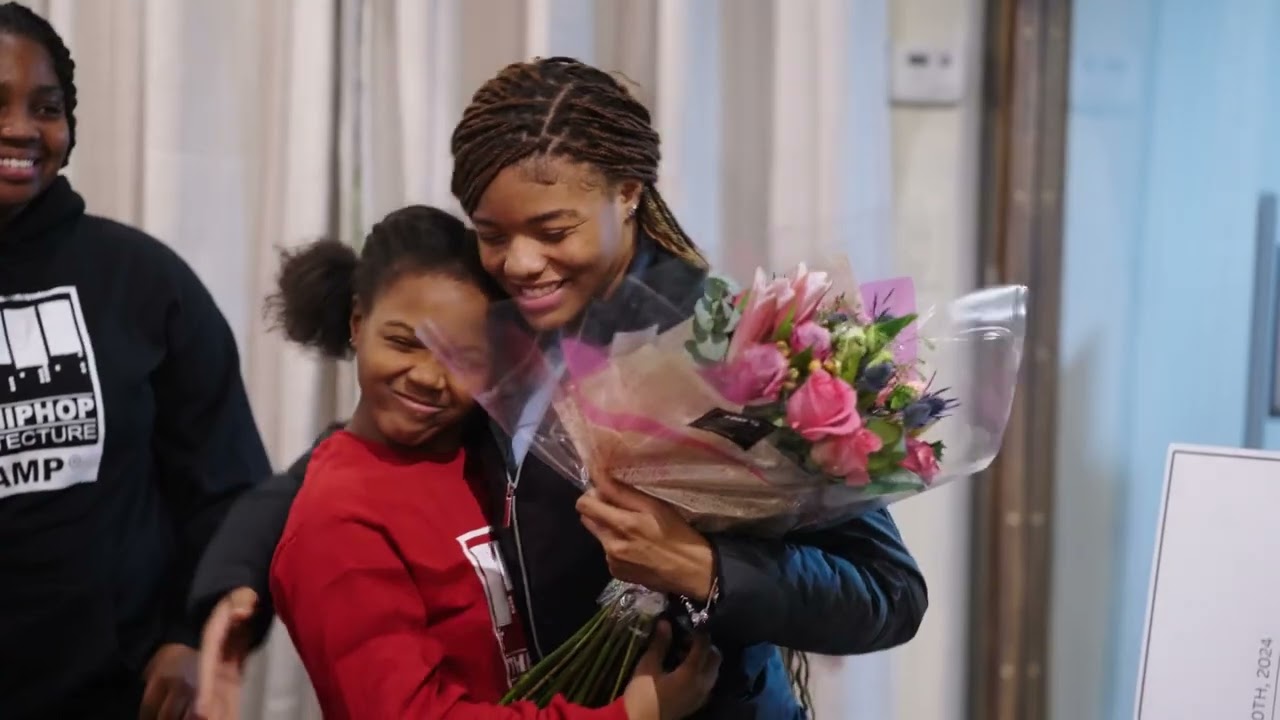
According to the National Council of Architectural Registration Boards, less than 0.5 percent of licensed architects in the U.S. are African American women. In an overwhelmingly white industry, Michael Ford — also known as The Hip Hop Architect — and his organization have been working for years to change those numbers. Recently, they presented Michael Ford’s annual $10,000 Hip Hop Architecture Scholarship to Kamryon Johnson, a sophomore at the University of Detroit Mercy’s School of Architecture and Community Development.
“This scholarship is not just an investment in Kamryon’s future — it’s an investment in the future of our communities and the profession of architecture,” Ford said during the Dec. 30 scholarship presentation.
Johnson maintains a 3.6 GPA at the University of Detroit Mercy while serving her university as a residential advisor (RA), and being an active member of the National Organization of Minority Architects (NOMA), recently attending her first NOMA National Conference.
“Kamyron is a student at the University of Detroit Mercy, where Michael went to school, and Detroit native, like Michael, so it was a full-circle moment,” N’dia Jones, chief of staff at BrandNu Design Studio, tells Madison365. “She had been a part of the hip-hop architecture camps. For a while, she had participated in our internships. She was actually in an internship the week that she found out that she won with us. So it’s really neat.”
The scholarship, funded by Michigan Central, was the result of a national search to support emerging talent in architecture. Johnson first discovered her passion for the profession at age 13 through Ford’s Hip Hop Architecture Camp.
Ford is committed to transforming the narrative for African Americans in architecture, who currently make up less than 2 percent of licensed architects in the United States.
“That percentage is very, very low for African Americans in the architectural field and for African American women, it’s even lower,” Jones says. “I think it is super impactful for other younger African American women to see Kamryon getting this scholarship, and to really just open their eyes up to the possibility of architecture.”
Ford is the founder of BrandNu Design Studio, a full-service architecture and design firm that has offices in Madison, Dallas, Detroit, and New York. “Michael is back home in Detroit often, but we also have a project in Milwaukee where we have been working on the Bronzeville Center for the Arts,” Jones says. Ford was the lead architect for The Hip Hop Museum in The Bronx, New York. “We have some recent projects that are exciting including at the Memphis Hip Hop Museum, which was just announced, where Michael will be the architect over that project, as well.”
Jones was part of the team that determined this scholarship winner and was really impressed by the resume of Johnson, who participated in the 2018 Hip Hop Architecture Camp at MOCAD in Detroit and went on to become the valedictorian of her high school class and received the prestigious Bergmeyer Design Hip Hop Architecture Travel Scholarship and Internship, representing the Hip Hop Architecture Camp in Boston for a week.
“It was a hard process to choose a winner. The amount of students that we had apply for this scholarship was amazing and many of them had 3.5 GPAs and higher. And so many of them were sitting on boards and had been to conferences and things like that,” Jones remembers. “So it was a difficult process in choosing, but, ultimately, we can only pick one. And so Kamyron really just exemplified all of the things that we were looking for in a student to receive the scholarship.”
The scholarship presentation, hosted by Ford at Pequeno Restaurant in Detroit, was an energetic party and a complete surprise for Johnson. (Video footage of the event was captured by Kardiak Films below.)
The presentation was attended by the Detroit City Council president, mayoral candidate Mary Sheffield and Asia Williams, the 2024/25 Hip Hop Architecture Fellow and adjunct professor at the University of Detroit-Mercy.
“I think that day was very special for her. It was a surprise. She had no idea; she thought she was going to get tacos,” Jones smiles. “And so they had everything set up for her including family and friends. It was just amazing.
“Kamyron is a super bright student, valedictorian of her high school … really just an amazing story for Michael [Ford] to be able to give that away to her,” she adds.
The journey for Johnson, who also gained valuable experience through the Hip Hop Architecture Camp’s internship program with BrandNu Design Studio, is proof that Hip Hop can inspire youth to explore careers in architecture and design.
“I think this scholarship is super impactful and I know for Michael it’s always a full-circle moment to be able to do things like this. For Michael growing up in Detroit, and then pursuing architecture himself, it’s great to see someone else, also a young person out of Detroit, who is really hungry for the profession and really ready to shine,” Jones says. “Kamyron also participated in the NOMA Conference, which is huge for someone her age to be going into those rooms and really putting herself out there to meet new people and to introduce herself as a future architect.”
Ford has made it his goal to increase the diversity in architecture.
“I think Michael is a big reason that things are shifting and changing the trajectory of who has exposure to architecture,” Jones says. “Overall, the scholarship will really help students finish strong in school, and in being able to pay for academics, books, and whatever it is that they might need to succeed, so that we can change that number and those percentages. We really want to inspire the younger generations and even the older generations to see the possibilities of Black people in architecture.”
The next Michael Ford’s $10,000 Hip Hop Architecture Scholarship Giveaway will take place in May 2025. Jones encourages people to stay tuned on their website, The Hip Hop Architecture Camp, for upcoming details on applications and requirements.
“We want to introduce architecture to the underserved communities that we’re working with … students who may not find architecture programs anywhere else,” Jones says. “They’re able to join these programs and then also open up doors for internship opportunities and scholarship opportunities.”


Recent Comments